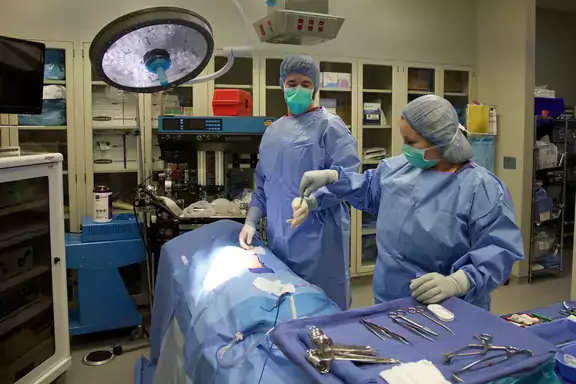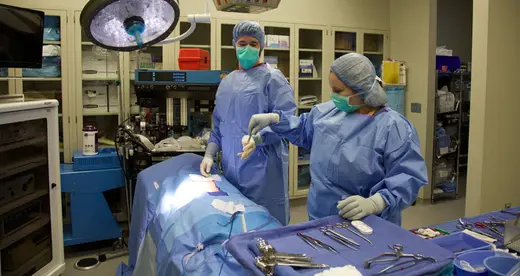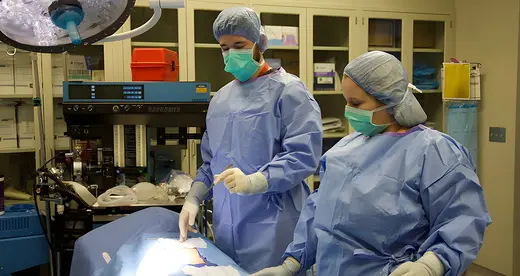Surgical Technology as a Career
Surgical technologists work under the direct supervision of a surgeon. The surgical technologist assumes specific responsibilities before, during, and after surgery. They are the only formally educated perioperative healthcare provider. The surgical technologist has the primary responsibility for maintaining the sterile field and being constantly vigilant that all members of the surgical team adhere to aseptic techniques to assure surgical patient safety.
Programs
| Title | Credential | Credit Hours | Link to program details |
|---|---|---|---|
| Surgical Technology A.A.S. | Degree | 68 | |
| Surgical Technology Bridge | Degree | 34 | |
Career Opportunities
Employment opportunities include labor/delivery/emergency departments, inpatient/outpatient surgery centers, dialysis units/facilities, physicians’ offices, and central supply processing units.
Good to Know
Before the operation, the certified surgical technologist (CST) prepares the operating room (OR) by supplying it with the proper supplies and instruments. Other preoperative duties include adjusting and testing equipment, preparing the patient for surgery, and helping to connect surgical equipment and monitoring devices. The CST is the first member of the OR team to transition into the sterile role (perform a surgical hand scrub and put on a sterile gown and gloves). The CST prepares the sterile setup for the appropriate surgical procedure, accounts for all items to be used for the surgery (sponges, needles, instruments, etc.), and assists other members of the sterile team as they transition into the sterile role.
During the operation, CSTs have the primary responsibility for maintaining the sterile field and anticipating their surgeon's needs. In order that surgery may proceed smoothly, CSTs possess an understanding of the surgery being performed so they may pass instruments and provide needed items in a prompt and efficient manner. CSTs prepare suture material, dispense medications, prepare specimens, and account for all items used in surgery (sponges, needles, instruments, etc.). CSTs may assist the surgeon with maintaining visibility through retraction of tissue and sponging or suctioning of fluid.
After the operation, CSTs are responsible for accounting for all items used in surgery (sponges, needles, instruments, etc.), applying dressings, patient care in preparation for transport, post-procedure instrument care, and preparing their assigned OR for subsequent cases.
CSTs work in clean, often brightly lit, quiet, cool environments. CSTs may be exposed to communicable diseases, unpleasant sights, foul odors, and hazardous materials. Most of their duties require standing, sometimes for a number of hours. It is imperative that the CST possess the ability to maintain their focus and attention on the task at hand. Most surgery is performed during the day, however, in larger facilities, it may be performed in the afternoon and evening. A 36 to 40-hour week is common with shift options of eight, ten, and twelve hours depending on the facility. Hospitals typically require 24-hour coverage outside of a routine surgical schedule. So in addition to their regular workweek, the CST will be required to periodically be "on-call" to come into work on short notice for emergency surgeries.
The ability to perform under pressure in stressful and emergency situations is a quality essential to CSTs. A stable temperament, a strong sense of responsibility, and concern for order are required. Manual dexterity and physical stamina are vital. CSTs must be able to work quickly and be able to integrate a number of activities according to priority. They should be able to navigate smaller spaces while adhering to the principles of asepsis. They must be keenly sensitive to the needs of the patient as well as to the needs of other members of the surgical team. Individuals who practice this profession have a strong desire to help others and make a valuable contribution to society.
- Association of Surgical Technologists (AST)
- A Career in Surgical Technology
- Accreditation Review Council on Education in Surgical Technology and Surgical Assisting (ARC/STSA)
- Commission on Accreditation of Allied Health Education Programs (CAAHEP)
- National Board of Surgical Technology and Surgical Assisting (NBSTSA)
BIO-168 Program entry pre-requisite course
Fall Semester I
- SUR-110 On-line
- SUR-111 On-line (Didactic); W or TH 8:00 a.m. - 12:00 noon and 1:00 p.m. - 3:00 p.m. (Lab)
*Students must be prepared to attend "open lab hours" outside the posted schedule
- BIO-169 (what fits into your SUR schedule)
- ENG-111 (what fits into your SUR schedule)
- ACA-115 (what fits into your SUR schedule)
Spring Semester I
- SUR-122 On-line (Didactic); TH 3:30 p.m. - 6:30 p.m. (Lab)
- SUR-123 M, T, TH 6:00 a.m. - 2:20 p.m. (clinical)
- BIO-175 (what fits into your SUR schedule)
Summer Semester
- SUR-134 On-line
- SUR-135 M, T, TH 6:00 a.m. - 1:20 p.m. (clinical)
- COM-120 (what fits into your SUR schedule)
Fall Semester II
- SUR-211 On-line
- SUR-212 M, T 6:00 a.m. - 1:20 p.m. (clinical)
- HUM-115 (what fits into your SUR schedule)
- PSY-150 (what fits into your SUR schedule)
Spring Semester II
- SUR-137 W 9:00 a.m. - 9:50 a.m.
- SUR-210 M or T or TH (clinical) 6:00 a.m. - 1:20 p.m.
*Students must be prepared to attend alternate clinical days in the event of inclement weather
- SOC-210 (what fits into your SUR schedule)
Rachel Vickers, AAS, CST
Chair, Surgical Technology Program
- Office Phone: (828) 398-7892
- Email: rachelvickers@abtech.edu
Valerie Clontz, AAS, CST
Clinical Coordinator, Surgical Technology Program
- Office Phone: (828) 398-7618
- Email: valerierclontz@abtech.edu



